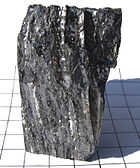
Beryllium

Beryllium is a chemical element with the symbol Be and atomic number 4. It is a relatively rare element in the universe, usually occurring as a product of the spallation of larger atomic nuclei that have collided with cosmic rays. Within the cores of stars, beryllium is depleted as it is fused into heavier elements. It is a divalent element which occurs naturally only in combination with other elements in minerals. Notable gemstones which contain beryllium include beryl (aquamarine, emerald) and chrysoberyl. As a free element it is a steel-gray, strong, lightweight and brittle alkaline earth metal. In structural applications, the combination of high flexural rigidity, thermal stability, thermal conductivity and low density (1.85 times that of water) make beryllium metal a desirable aerospace material for aircraft components, missiles, spacecraft, and satellites. Because of its low density and atomic mass, beryllium is relatively transparent to X-rays and other forms of ionizing radiation; therefore, it is the most common window material for X-ray equipment and components of particle detectors. The high thermal conductivities of beryllium and beryllium oxide have led to their use in thermal management applications. When added as an alloying element to aluminium, copper (notably the alloy beryllium copper), iron or nickel beryllium improves many physical properties. Tools made of beryllium copper alloys are strong and hard and do not create sparks when they strike a steel surface. Beryllium does not form oxides until it reaches very high temperatures. The commercial use of beryllium requires the use of appropriate dust control equipment and industrial controls at all times because of the toxicity of inhaled beryllium-containing dusts that can cause a chronic life-threatening allergic disease in some people called berylliosis. Beryllium is a steel gray and hard metal that is brittle at room temperature and has a close-packed hexagonal crystal structure. It has exceptional stiffness (Young's modulus 287 GPa) and a melting point of 1287 C. The modulus of elasticity of beryllium is approximately 50% greater than that of steel. The combination of this modulus and a relatively low density results in an unusually fast sound conduction speed in beryllium – about 12.9 km/s at ambient conditions. Other significant properties are high specific heat (1925 J·kg−1·K−1) and thermal conductivity (216 W·m−1·K−1), which make beryllium the metal with the best heat dissipation characteristics per unit weight. In combination with the relatively low coefficient of linear thermal expansion (11.4×10−6 K−1), these characteristics result in a unique stability under conditions of thermal loading. Naturally occurring beryllium, save for slight contamination by the cosmogenic radioisotopes, is isotopically pure beryllium-9, which has a nuclear spin of 3/2. Beryllium has a large scattering cross section for high-energy neutrons, about 6 barns for energies above approximately 10 keV. Therefore, it works as a neutron reflector and neutron moderator, effectively slowing the neutrons to the thermal energy range of below 0.03 eV, where the total cross section is at least an order of magnitude lower – exact value strongly depends on the purity and size of the crystallites in the material. The single primordial beryllium isotope 9Be also undergoes a (n,2n) neutron reaction with neutron energies over about 1.9 MeV, to produce 8Be, which almost immediately breaks into two alpha particles. Thus, for high-energy neutrons, beryllium is a neutron multiplier, releasing more neutrons than it absorbs. This nuclear reaction is: Neutrons are liberated when beryllium nuclei are struck by energetic alpha particles producing the nuclear reaction where 42He is an alpha particle and 126C is a carbon-12 nucleus.Beryllium also releases neutrons under bombardment by gamma rays. Thus, natural beryllium bombarded either by alphas or gammas from a suitable radioisotope is a key component of most radioisotope-powered nuclear reaction neutron sources for the laboratory production of free neutrons.
